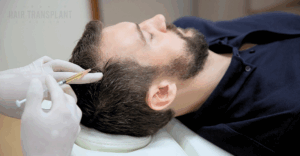Because there are so many factors that contribute to why people lose their hair – genetics and hormones both play a role – hair-loss experts have only found a few treatments that are actually effective for people who are starting to experience baldness, though they don’t work well for everyone. That makes the recent findings of a team of researchers from across the pond especially promising.
The U.K.-based research group discovered that a drug used to treat osteoporosis has the potential to restore hair growth.
A Possible Solution for Baldness?
A study conducted by the University of Manchester’s Center for Dermatology Research says the drug, named WAY-316606, stimulated hair growth under lab-controlled conditions by targeting a protein that halts hair growth and contributes to baldness.
The research group behind the study was originally testing cyclosporine A, a fungal-derived immunosuppressive drug that has been used since the 1980s to stop rejections in organ transplants and mitigate symptoms of autoimmune diseases. One of its known side effects is triggering hair growth all over the body by inhibiting a protein called SFRP1.
While researchers found cyclosporine A did successfully lead to hair growth, it had severe side effects that made it unsuitable. So the team kept searching for a drug with similar attributes, and eventually, they found it in WAY-316606. After testing it on isolated sample hair follicles from a human scalp, scientists learned the compound promoted hair growth in as little as two days, without dangerous side effects.
Someday, WAY-316606 Could Reverse Balding
Learning that this new drug, which people had never previously considered in the context of treating hair loss, promotes human hair growth could one day represent a major breakthrough for men and women who suffer from hair loss.
There are only two hair-loss drugs currently available on the market: minoxidil, used in Rogaine, and finasteride, also known as Propecia. However, these drugs don’t work for everyone, and can have severe side effects.
Minoxidil works for only about 30 to 40 percent of patients and can bring about rapid heart rate and irritation. In addition, once you start using it, you can’t stop, unless you want to start losing hair again. Meanwhile, Finasteride is only suitable for male use, is not successful for everyone and can cause a range of side effects, including sexual dysfunction.
That’s why the potential for a new drug that can reverse hair loss is creating such a buzz. However, the key word to keep in mind here is potential – there are still a few hurdles to clear before this drug could become available commercially.
Completing the Clinical Trial Process
Although the study authors concluded WAY-316606 has the “potential to treat human hair loss disorders,” so far it has only been tested on sample hair follicles under lab conditions – not on actual, living humans. Until WAY-316606 is tested on a large group of people over a long time, it’s hard to say how well it works and how safe it is. A clinical trial is required to make sure the drug not only works, but is also safe to use.
So, what is a clinical trial? This process is the primary way researchers find out if a new drug, treatment or medical device is safe for humans to use. Often, a clinical trial helps determine if drugs have any harmful risks, side effects or interactions with other substances.
In the U.S., clinical trials must pass through four phases to test a treatment, find the appropriate dosage and identify side effects. If researchers determine the a drug to be safe after the first three phases, the FDA approves it for clinical use and continues to monitor its effects.
● A Phase I trial tests an untried treatment on about 20 to 80 healthy people to judge its safety and side effects and to determine the correct drug dosage.
● While Phase I places the largest emphasis on safety, a Phase II trial is focused mostly on effective use. By studying the effects of a drug, treatment or device on a larger group of 100 to 300 people, the goal of this phase is to collect preliminary data on whether the treatment works for people who have a certain disease or condition. These trials also continue to examine safety, including any short-term side effects. This phase can last several years.
● A Phase III trial collects more information about safety and effectiveness, studying different populations and different dosages, using the drug in combination with other drugs. The number of subjects in a Phase III trial usually ranges from several hundred to up to several thousand people. If the FDA agrees the trial results are encouraging, it will approve the experimental drug or device.
● A Phase IV trial for drugs or devices takes place after the FDA approves their use. A device or drug’s effectiveness and safety are observed among large, varied groups of people. Sometimes, the side effects of a drug may not become clear until more people have taken it over a longer period.
Because the clinical trial process is so thorough, it often takes several years between the time researchers initially discover a drug and when it is finally determined to be safe for human use or consumption. So, while the discovery of WAY-316606 is exciting, it doesn’t necessarily guarantee the drug will become publicly available anytime soon.
In the meantime, if you are concerned or frustrated about your hair loss and would like to speak to a specialist about your options, contact Dr. Robert Jones for a free, no-obligation consultation. Dr. Jones is a respected hair-loss surgeon and an expert in his field who has helped hundreds of people from all around the world regrow their hair with his cutting-edge techniques and many years of training.
As a pioneer of the follicular unit extraction technique, Dr. Jones can give you a natural, healthy-looking head of hair with no linear scarring. Why wait around for scientists to find the “magic pill” for hair loss when you could be enjoying your new hair sooner with the help of an experienced professional?





